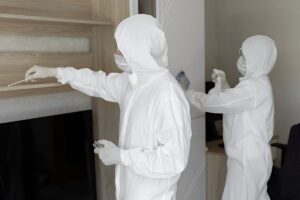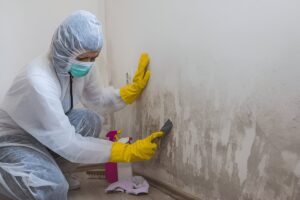Moisture leaks can be a silent menace in homes, particularly in regions with high humidity levels like Edison. These leaks, often overlooked, can lead to significant damage and health risks if not addressed promptly. Understanding the implications of moisture leaks is crucial for homeowners who wish to maintain a safe and healthy living environment. This article delves into the various aspects of moisture leaks, their causes, effects, and preventive measures to safeguard your home.
Understanding Moisture Leaks
Moisture leaks refer to the unintended escape of water from plumbing systems, roofs, or walls, leading to excess humidity in the home. These leaks can originate from various sources, including:
- Roofing Issues: Damaged shingles or flashing can allow rainwater to seep into the home.
- Plumbing Failures: Leaky pipes, faucets, or toilets can contribute to moisture accumulation.
- Poor Ventilation: Inadequate airflow can trap humidity indoors, exacerbating moisture problems.
Identifying the source of moisture leaks is the first step in mitigating their effects. Regular inspections of your home can help detect potential issues before they escalate.
The Health Risks Associated with Moisture Leaks
One of the most concerning aspects of moisture leaks is their impact on health. Excess moisture creates an ideal environment for mold and mildew growth, which can lead to various health issues, including:
- Respiratory Problems: Mold spores can trigger asthma attacks and other respiratory conditions.
- Allergic Reactions: Exposure to mold can cause allergic reactions, including sneezing, itching, and skin rashes.
- Infections: Certain types of mold can lead to serious infections, particularly in individuals with weakened immune systems.
To protect your family’s health, it is essential to address moisture leaks promptly and effectively.
Identifying Signs of Moisture Leaks
Detecting moisture leaks early can save homeowners from costly repairs and health risks. Here are some common signs to watch for:
- Water Stains: Discoloration on walls or ceilings can indicate a leak.
- Musty Odors: A persistent damp smell often suggests mold growth.
- Peeling Paint or Wallpaper: This can be a sign of moisture trapped beneath the surface.
- Increased Humidity: A noticeable rise in indoor humidity levels can signal a moisture problem.
Regularly inspecting your home for these signs can help you catch moisture leaks before they become a significant issue.
Common Sources of Moisture Leaks
Understanding the common sources of moisture leaks can help homeowners take preventive measures. Some typical culprits include:
Plumbing Systems
Leaky pipes are one of the most frequent sources of moisture leaks. Over time, pipes can corrode, leading to small leaks that may go unnoticed. Regular plumbing inspections can help identify and address these issues before they escalate.
Roof Damage
A compromised roof can allow rainwater to infiltrate your home. Regular roof inspections, especially after severe weather, can help identify potential vulnerabilities.
Windows and Doors
Improperly sealed windows and doors can let in moisture, particularly during heavy rain. Ensuring that seals are intact and weather stripping is in good condition can help prevent leaks.
Foundation Issues
Cracks in the foundation can allow groundwater to seep into your home. Regularly inspecting your foundation for cracks and addressing them promptly can help mitigate this risk.
The Impact of Moisture Leaks on Property
Moisture leaks can have devastating effects on your property. Some of the potential impacts include:
- Structural Damage: Prolonged exposure to moisture can weaken the structural integrity of your home, leading to costly repairs.
- Mold Growth: As mentioned earlier, moisture creates an ideal environment for mold, which can damage walls, ceilings, and personal belongings.
- Pest Infestations: Excess moisture can attract pests like termites and rodents, leading to further damage.
To protect your investment, it is crucial to address moisture leaks as soon as they are detected.
Preventive Measures Against Moisture Leaks
Preventing moisture leaks is essential for maintaining a healthy home environment. Here are some effective strategies:
Regular Inspections
Conducting regular inspections of your home can help identify potential moisture issues before they escalate. Pay close attention to areas prone to leaks, such as basements, attics, and around windows and doors.
Proper Ventilation
Ensuring adequate ventilation in your home can help reduce humidity levels. Use exhaust fans in bathrooms and kitchens, and consider installing vents in areas prone to moisture buildup.
Repairing Damage Promptly
Addressing any damage to your roof, plumbing, or foundation promptly can help prevent moisture leaks. Regular maintenance checks can help identify issues before they become significant problems.
Using Moisture Barriers
Installing moisture barriers in areas prone to leaks, such as basements and crawl spaces, can help prevent moisture infiltration. These barriers can be particularly effective in areas with high groundwater levels.
Dealing with Existing Moisture Leaks
If you discover moisture leaks in your home, it is essential to take immediate action. Here are some steps to follow:
Identify the Source
Determine the source of the moisture leak and address it promptly. This may involve repairing plumbing, sealing windows, or addressing roof damage.
Dry Affected Areas
Use fans and dehumidifiers to dry out any affected areas. It is crucial to dry these areas within 24-48 hours to prevent mold growth.
Clean and Disinfect
Once the area is dry, clean and disinfect surfaces to eliminate any mold spores that may be present. Use a mixture of water and detergent or a commercial mold cleaner.
Seek Professional Help
In cases of severe moisture leaks or mold infestations, it may be necessary to seek professional assistance. Mold remediation specialists can help ensure that your home is safe and free from mold.
The Role of Insurance in Moisture Leak Damage
Homeowners insurance can play a crucial role in protecting your property from the financial impact of moisture leaks. Here are some key points to consider:
- Coverage for Water Damage: Many homeowners insurance policies cover water damage caused by sudden and accidental leaks. However, coverage for gradual leaks may vary, so it is essential to review your policy.
- Mold Coverage: Some policies may include coverage for mold remediation, while others may not. Understanding your policy’s specifics can help you prepare for potential costs.
- Preventive Measures: Some insurance companies offer discounts for homeowners who take preventive measures against moisture leaks, such as installing sump pumps or dehumidifiers.
Regularly reviewing your insurance policy and discussing coverage options with your agent can help ensure that you are adequately protected.
Conclusion
Moisture leaks are a hidden danger that can lead to significant damage and health risks in Edison homes. By understanding the causes and effects of moisture leaks, homeowners can take proactive measures to prevent them. Regular inspections, proper ventilation, and prompt repairs are essential for maintaining a safe and healthy living environment. Additionally, understanding the role of insurance can provide peace of mind in the event of moisture-related damage. Protect your home and family by staying vigilant against the dangers of moisture leaks.
For more information about Moisture leaks in Edison New Jersey please contact:
Business Name: Green Guard Mold Remediation of Edison
Address: 6 Kilmer Rd, Edison, NJ 08817, United States
Phone: 908-762-8046




